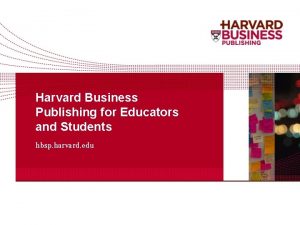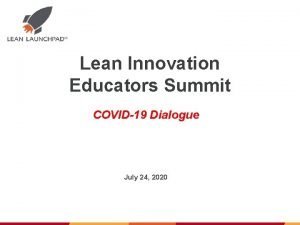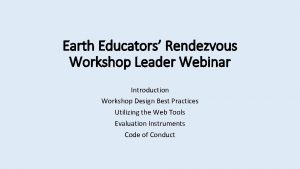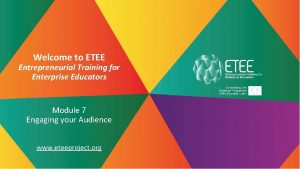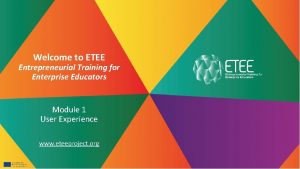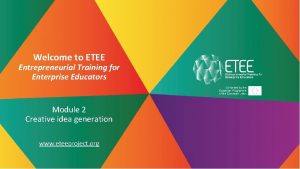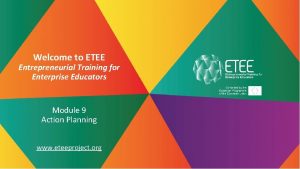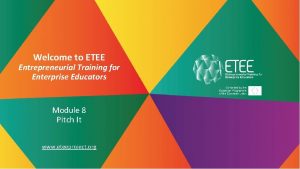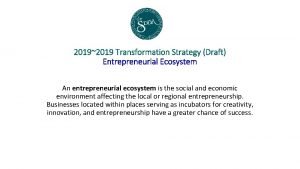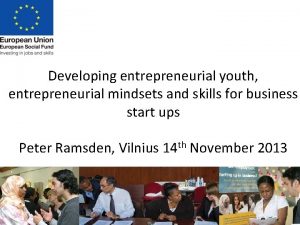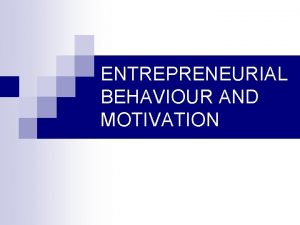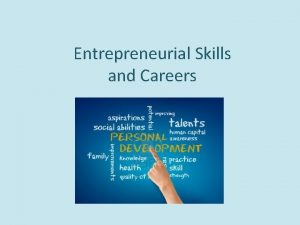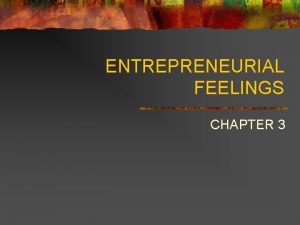Welcome to ETEE Entrepreneurial Training for Enterprise Educators






































- Slides: 38

Welcome to ETEE Entrepreneurial Training for Enterprise Educators Module 3 Assemble your Toolkit www. eteeproject. org

ETEE Canvas BUILD IT USE IT User experience (1) Understanding stakeholders (4) Engaging your audience (7) Creative idea generation (2) Scoping the environment (5) Pitch it (8) Assemble your toolkit (3) Determining success criteria (6) Action planning (9) HOW? WHAT? WHO? DREAM IT

Overview • We will explore a range of resources designed to inspire and enable an entrepreneurial approach to teaching and learning.

Learning Outcomes: Module 3 • Identify and access a wide range of resources & inspiration; • Formulate opportunities to enhance your own programme delivery.

More Information at: http: //Europa. eu/!fb 73 BK https: //t. co/Hrt. Bxh. XUk. I What is “Entrecomp”? Summary Video: http: //publications. jrc. europa. eu/repository/handle/JRC 109128 https: //ec. europa. eu/avservic es/video/player. cfm? ref=I 163 141&lg=EN&sublg=none

Entre. Comp: Resources 2. 3. Mobilising Resources Gather and manage the resources you need • Get and manage the material, non-material and digital resources needed to turn ideas in action.

Module Icebreaker Creating the Line of Enterprise!

Once the “line is established reflect upon… • Are you in the right place? And why? • What questions did you ask to secure your position? – what else could you have asked? • Can you see anyone that you would move up the line? And why? • What do you personally need to do to improve your position? (action planning) • Who would you want to connect with/work with going forward? What would you do next time?

Review of Techniques: Line of Entrepreneurship • Purpose: • Importance of learning from all others; valuing different experiences and perspectives; • Appreciate experience and wisdom in the room and how it can be relevant; • Understand capacity & expertise within our Educator Network. • Use with Students: • • Physically engages students; memorable; quick way to energise individuals; Confidence Building; Helps you understand their confidence in their own subject knowledge; Shows breadth and dimensions of subject area. Needs Review and Reflection to draw out the lessons / experience (Can create a circle or partner students or build a network of skills from the line)

https: //www. etctoolkit. org. uk/all-etc-how-toguides-case-studies/? toolkitid=1441

Activity 1: “if only…” Use of Post-its (Race 2014) In your “user” focused groups, think about your user group, their needs, and the challenge/programme you have identified. Working together explore the idea in more depth asking: “if only there was…” • Now: Write as many of your ideas as you can onto post-its to create your team “wish list”; • Group your ideas together to identify your top 3 needs/wishes and present as a poster (flipchart) to the whole group.

Activity 1: “if only…” (Race 2014) Part 1: Review As an ETEE cohort: • Listening to the “ 3 wishes” (or looking at the posters) can the group now work together to pool their knowledge to support each other? Are there any connections / materials / resources to be shared? Part 2: To follow Creating your own agenda. https: //www. etctoolkit. org. uk/all-etc-how-to-guides-casestudies/? toolkitid=1543

Review of Techniques: “if only…” • Purpose: • To help students think about a task creatively and without limits; • To explore solutions without being constrained by barriers/limits. • Use with Students: • Need to encourage them to think more creatively by using “wishes” metaphor; • Use post-its to stop one group member dominating. Advice/Notes Kit required to engage all students directly (post-its; flip chart)

Activity 2: Creating your own agenda (Race 2014) Using the “wish list” posters created by the groups, add your comments using either YELLOW or GREEN post-its POST IT 1: YELLOW Write down a question that you think might be important to you taking this forward… (something you maybe don’t know the ‘best’ answer to…) POST IT: 2 GREEN Write down something you do know about this…. . . or something you want to share!

Group Discussion • What is in our collective ETEE toolkit? • Where else can you look to find guidance in other areas? Make notes into your ETEE Canvas!

Review of Technique: Creating your own agenda • Purpose: To help identify what student groups know already about a topic • Learners are given the opportunity to compose questions about a topic new to them; (links to intended learning outcomes); • Learners are enabled to contribute things they already know about a new topic (links to learning incomes); • Learners are helped to learn from what each other already knows; • Learners can gain confidence finding out that many others have similar questions. • Use with Students: • Can be used at the start of a project to engage students to bring their knowledge/experience together on a new subject. Advice/Notes Kit required (2 different colours of post-its) Can be returned to, to show student group how you understand value their prior-learning Source: https: //www. etctoolkit. org. uk/all-etc-how-to-guides-case-studies/? toolkitid=1542

From the ETC Tool. Kit: Creating your own agenda https: //www. etctoolkit. org. uk/all-etc-how-toguides-case-studies/? toolkitid=1542

Effectuation Theory (Sarasvathy 2001) says entrepreneurs start “where they are” → What’s your starting point? → What resources do you have? Think about: • Your team; • Your skills, strengths, knowledge and networks; • Your social, human, financial resources. Bird in the hand principle: https: //www. effectuation. org

Activity – Find your network

Activity – Find your network

Review of Techniques: Find your network • Purpose: • To help participants to think about themselves as being part of a network; • To explore connections and resources (social capital). • Use with Students: • Need to encourage them to think deeply about themselves. Advice/Notes Can be done with either print out of a square (web page) or just blank paper

Capture your Resource profile Social, Financial, Human

Build your OWN Resource Profile Human, social & financial capital • What you know - skills, knowledge and experience • Who you know - networks and strength of relationships • Financial & physical assets that you have, or can access Human Capital Financial Capital Social Capital


www. etctoolkit. org. uk The Toolkit already contains well over 200 ideas for inspirational teaching, contributed by 50 educators from 20 institutions, as well as links to useful resource materials already developed by @EEUK members and HEA, NCEE and NESTA www. etctoolkit. org. uk

Case examples of practice

Review: what activities are in your ETEE toolkit? Group Discussion: Group Activities (learning and teaching) 1. List: Which ones worked well for you? (make an individual list) 2. Discuss: What learning did each activity provide? 3. Explain: How did it ‘feel’? How do you feel now about the next task? (which activities built your entrepreneurial competences? ) 4. Next Steps: Which activities can you take forward?

What Institutional support is available? Insert local/national resources (language) that might assist. The next slide includes the UK national resource. When editing, please include resources in your own national language.

Signposting: United Kingdom

Activity: “What can I do when…” (Race 2014) In new /mixed small groups: • Imagine delivering your new programme, and thinking negatively, write a list that identifies all the problems or concern you have in developing your idea/programme (challenge); • Outline your concern with your cohort, and invite them to discuss in small groups and then present their top tips/solutions to the groups; • Capture the solutions / share advice and resources. https: //www. etctoolkit. org. uk/all-etc-how-to-guides-case-studies/? toolkitid=1540

Review of Technique: What can you do when? • Purpose: • Help with creative problem solving. • Use with Students: • Encourage the students to have an open discussion – no shutting down of ideas/conversations; • Support a “building” approach to conversation and discussion. Note/Advice You can also try ‘Negative brainstorming’, if the exercise includes ‘What would make this situation worse? ’, which can often yield further ideas for actual solutions to the problem.

ETCToolkit: what can you do when… (Race 2004)

Reflection & Review: As an educator ask yourself… • Why and when would I use this? • Can I use it? Should I replace anything I already do? (is what I do better? ) • How does it ‘feel’ (to undertake/to deliver)? • Could I do this? (with my students; my classroom situation (room type) etc. ) • What support do they need (in advance or during)? • What support do I need? • How do I assess this? do I need to? Source: Price (2014)

Self-assessment: Can you… • In a short sentence, articulate the importance of social capital? • Map your own network? • Signpost your students to institutional or national support that is available? • Build your own toolkit to use?

Your ETEE Canvas: REFLECTION Where next? Create your entrepreneurial programme! • Think about your entrepreneurial learning workshop / activity / programme; • Describe your own entrepreneurial programme: What is the purpose of the programme? (2) How will you get support for what you are doing? (8) Who is it for? (1) How will it help learners / participants to develop their entrepreneurial skills? (2) Who can help you? (3, 4) How will you engage participants? (7, 5) What actions do you need to take? (learning, teaching and assessment) (6) What resources do you need? (3, 5) • Make a note on your ETEE Canvas.

Takeaways • Adaptable activities • Line of Enterprise; • What if… Examples of the use of ETCToolkit to support programme development • Understanding of the importance of social and human capital • Problem solving (what to do when. . ); • Connecting you to others (network); • Supporting you in your new venture.

BUILD IT USE IT User experience (1) Understanding stakeholders (4) Engaging your audience (7) Creative idea generation (2) Scoping the environment (5) Pitch it (8) Assemble your toolkit (3) Determining success criteria (6) Action planning (9) HOW? WHAT? WHO? DREAM IT

W W W. E T E E P R O J E C T. O R G Consortium: This project has been funded with support from the European Commission. This publication reflects the views only of the author, and the Commission cannot be held responsible for any use which may be made of the information contained therein. Project Nº 2017 -1 -PL 01 -KA 201 -038795.
 Etee review
Etee review Missouri educators trust
Missouri educators trust Professional association of georgia educators
Professional association of georgia educators New york harm reduction educators
New york harm reduction educators Hbsp coursepack
Hbsp coursepack Texas assessment management system administrator
Texas assessment management system administrator Lean innovation educators summit
Lean innovation educators summit Georgia code of ethics for educators
Georgia code of ethics for educators Allied educator moe
Allied educator moe Measurement and evaluation for health educators
Measurement and evaluation for health educators Ga ethics exam
Ga ethics exam Earth educators rendezvous
Earth educators rendezvous Putting the enterprise into the enterprise system
Putting the enterprise into the enterprise system Putting the enterprise into the enterprise system
Putting the enterprise into the enterprise system Wise men three clever are we
Wise men three clever are we Kontinuitetshantering i praktiken
Kontinuitetshantering i praktiken Novell typiska drag
Novell typiska drag Tack för att ni lyssnade bild
Tack för att ni lyssnade bild Vad står k.r.å.k.a.n för
Vad står k.r.å.k.a.n för Varför kallas perioden 1918-1939 för mellankrigstiden?
Varför kallas perioden 1918-1939 för mellankrigstiden? En lathund för arbete med kontinuitetshantering
En lathund för arbete med kontinuitetshantering Underlag för särskild löneskatt på pensionskostnader
Underlag för särskild löneskatt på pensionskostnader Tidbok för yrkesförare
Tidbok för yrkesförare A gastrica
A gastrica Vad är densitet
Vad är densitet Datorkunskap för nybörjare
Datorkunskap för nybörjare Stig kerman
Stig kerman Hur skriver man en tes
Hur skriver man en tes Autokratiskt ledarskap
Autokratiskt ledarskap Nyckelkompetenser för livslångt lärande
Nyckelkompetenser för livslångt lärande Påbyggnader för flakfordon
Påbyggnader för flakfordon Tryck formel
Tryck formel Offentlig förvaltning
Offentlig förvaltning I gullregnens månad
I gullregnens månad Presentera för publik crossboss
Presentera för publik crossboss Vad är ett minoritetsspråk
Vad är ett minoritetsspråk Plats för toran ark
Plats för toran ark Klassificeringsstruktur för kommunala verksamheter
Klassificeringsstruktur för kommunala verksamheter Fimbrietratt
Fimbrietratt




